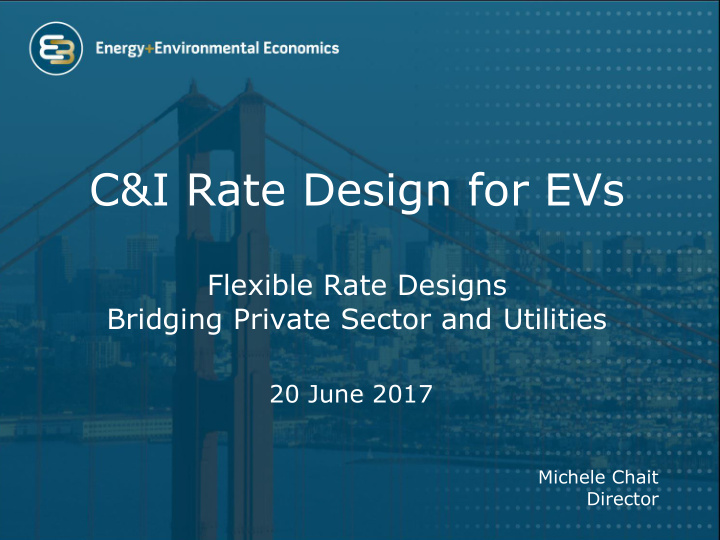



C&I Rate Design for EVs Flexible Rate Designs Bridging Private Sector and Utilities 20 June 2017 Michele Chait Director
About E3 Headquartered in San Francisco, founded in 1989 Economics and grid impacts of EVs, and supporting utilities in development of EV programs Long term CO2 pathways and impact of clean transportation (electric and gas) Large electric user rate discounts & procurement analysis to reduce costs and achieve sustainability goals 2
Key Rate Design Criteria Electric vehicle rate design should incorporate best practices in rate design (Bonbright Principles) • Customer understanding & ease of implementation • Collect utility’s cost of service • Current customers pay for use of current assets • Fairly apportion the annual cost of service among customers & avoid undue discrimination Balancing these principles can be an art rather than a science and can involve prioritizing policy goals 3
Rate Designs & EV Applications Example Load/Customer Types Airport GSE* Public DCFC Flexible Charging Inflexible Charging Off-peak period On-peak period TOU energy rates Energy-only rates • • Dynamic rates such as • Energy SDG&E’s VGI rate Rate Design High on-peak demand Low on-peak demand • • charges charges Demand Rate Design Diverse charging profiles across EV applications means there are no universally appropriate rate designs However, there are universally applicable EV discount structures • Sharing of benefits related to increased throughput • Reduced charges while usage grows 4 * Ground support equipment
Contribution to Margin Concept Contribution to Margin (CTM) from PEV Charging Load Annual Bill ($) Increased throughput from electric vehicles provide downward pressure on rates & increased CTM Benefit typically diminishes with customer size • Utility rates for small and medium-sized users are typically greater than utility’s marginal costs of serving load 5
Example: Rate Discounts to Support Electrification The Port of Long Beach expects its electric usage to quintuple to 250 MW from 2010 to 2030 largely due to electrification The Port’s Maritime Entity customers receive two types of electricity discounts under Southern California Edison’s (SCE) Schedule ME • A discount of 50% of the contribution to margin (CTM) for each customer in each month: • CTM = customer’s bill minus marginal costs * monthly usage • New electric infrastructure loads above 10 MW are to be supplied at 50 kV: • Can yield additional demand charge reductions above 2kV-50kV service Discounts recognize that electricity cost reductions can help support the Port’s electrification program, contributing to improved air quality in region 6
Example: SCE’s Optional EV Rates SCE’s new EV rate option balances many of these issues Three new, optional commercial rate schedules — EV-7 (<20 kW), EV-8 (21-500 kW) and EV-9 (> 500 kW) • TOU energy-only for 5 years, includes generation capacity • Demand charge phase-in years 6-10 • From year 11 • 60% of distribution demand and 100% of transmission in demand • 40% of distribution demand in energy (incentivizes off-peak use) Revenue neutral to the non-EV rates that would otherwise serve the EV customers • Helpful in early years but users with load factor above class average and on-peak users will likely pay more 7
Outside-of-the-Box Ideas BIP & Conjunctive Billing Interruptible rates • i.e , SCE’s BIP program reduces generation capacity charge • Called ~once a year https://campaignsoftheworld.com/outdoor/mini-outside-the-box/ • Load factor impacts Conjunctive Billing • Commonly used for electrifi ed rail, conjunctive billing calculates demand charges based on the highest combined load across all the EVSP’s accounts in a utility’s service area rather than at each individual location • Results in savings if chargers are not in use simultaneously 8
Outside of the Box ( con’t ) Economic Development Rates Economic development rates (EDR) provide rate discounts to attract or retain commercial loads • PG&E EDR standard discount of 12% for 5 years • Enhanced EDR Option provides a 30% discount for customers located in an area with annual unemployment rate greater than 125% of Perhaps a similar structure state’s average could be applied to promote vehicle electrification in • “But For” test areas with poor air quality https://www.pge.com/tariffs/tm2/pdf/ELEC_SCHEDS_EDR.pdf http://www3.sce.com/sscc/law/dis/dbattach5e.nsf/0/F5582C9D0A9A3659882580AE007F74A4/$FILE/A1701XXX- SCE%20TE%20Testimony%201-20-17.pdf, p. 14 9
Example Application: DCFC Problem: Tesla’s National DCFC Network • DCFC typically served on C&I rates which include demand charges. • Growing usage Potential Solutions: • EDR-style fixed % discount • Shared throughput discount • Reduced demand charges or energy- only rates Benefits: • Timing shifts costs into later years from upfront (assuming growth) • Requires care to ensure costs are not over-recovered in later years • Potential for stranded costs if EV charging load fails to materialize 10
Thank You! Energy and Environmental Economics, Inc. (E3) 101 Montgomery Street, Suite 1600 San Francisco, CA 94104 Tel 415-391-5100 Web http://www.ethree.com Michele Chait (michele@ethree.com)
Recommend
More recommend